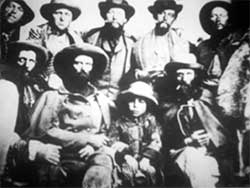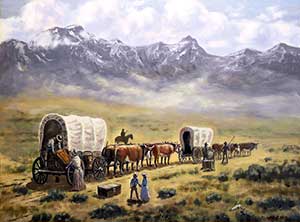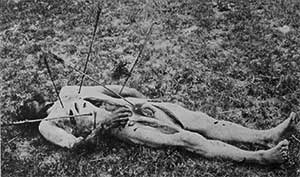The Utter Wagon Train Disaster

On September 9th, 1860 the Elijah P. Utter wagon train was attacked by Indians along the South Alternate of the Oregon Trail northeast of the present day town of Murphy, Idaho. The forty-four member wagon train was composed of four families with twenty-one children, some single men, five recently discharged soldiers and an army deserter. The two-day encounter resulted in the deaths of eleven emigrants by an estimated twenty-five to thirty Indians.
The first attack occurred on the high ground just west of Castle Creek when the Indians attempted to stampede the stock. The strong position of the hurriedly circled wagons and the distribution of food to the Indians discouraged additional aggression. The train was allowed to continue on toward the Snake River where the emigrants intended to fill their water barrels. The train kept to the high ground but was attacked again while passing down to Henderson Flat. The wagons were circled and the fight continued into the next day.
Toward sundown on the second day, each family hitched up a wagon and left the remaining wagons and loose stock for the Indians. But the hungry, thirsty and wounded oxen could not advance. The attackers pressed their advantage and forced the emigrants to abandon their property and flee. A wounded Elijah Utter was shot down and his wife, Abagel and three of his children refused to abandon him. All were killed.
The survivors escaped with only the clothes they were wearing, some firearms, and a few basic necessities. For over a week they worked their way down the Snake River, hiding in the daytime, walking at night. They traveled over seventy-five miles to the Owhyee River crossing until they were physically too weak to go on. Some were wounded and all were hungry and exhausted. Here eighteen children, six surviving parents and a young man waited to be rescued.

Two weeks later, the camp was visited by a few Shoshoni Indians. They traded salmon for what few possessions the survivors still harbored, and forcefully took their firearms. After receiving some salmon, the Van Ornum family, a young man named Gleason, and the two surviving Utter boys left the camp in hopes of finding a relief party. A short distance northwest of Farewell Bend, they encountered Indians. The three Van Ornum girls and their little brother were taken captive. The bodies of the others were discovered by soldiers in an old crater near the site.
Captain Frederick T. Dent, leader of the Army Relief Expedition, reported that a party led by Lieutenant Marcus A. Reno discovered, gleaming in the moonlight, dead, stripped and mutilated lay the bodies of six persons… Mrs. Vanorman had been whipped, scalped and otherwise abused by her murderers; the boys, Charles and Henry Otter, were killed by arrows, Mr. Vanorman, Marcus Vanorman and Gleason had their throats cut, and besides were pierced by numerous arrows. They appeared to have been dead from four to six days, the wolves had not yet molested them, decomposition was going on however, and Lieutenant Reno buried them.

The bodies were buried where they were found. Mrs. Van Ornum's body was laid to rest four and one-half feet deep, separate from the common grave containing the five remains of the men and boys. Local historian P.D. Wood rediscovered the graves and placed a small metal cross to mark the site.
At the Owyhee River camp, Mr. Daniel A. Chase Sr. died on October 13th, Libbie Trimble passed away, and five days later her baby sister died. The next day, Danny Chase died, followed two days later by his brother, Albert. All four children died from starvation. After much discussion and prayer, those who remained resolved to eat the flesh of the recently departed with the hopes of preserving their own lives until a rescue party arrived.
On October 24th, an Army relief expedition led by Captain Frederick T. Dent rescued ten survivors. They were the Joseph Meyers family of seven, Elizabeth Chase and daughter Mary and Emeline Trimble. Captain Dent reported: found the remains of Christopher Trimble, who had been murdered by the Indians; his body had been much disturbed by the wolves, but sufficient remained to identify it… This boy of eleven years of age, deserves special mention. He had killed several Indians in the fight… he then became a prisoner voluntarily with the Indians, in order that he might get some salmon taken to the camp… Two weeks had elapsed since his last visit; it must have been at that time he was killed.
Zacheus Van Ornum became an Indian Scout for the Army in an effort to rescue his nieces and nephew. The captive children were traded or stolen by other bands. Reuben Van Ornum was rescued by California Army Volunteers in November of 1862 in the Cache Valley of Utah. Unfortunately, he could not adapt to civilized life again. The youngest sister, Lucinda, died soon after being rescued from the Indians by Northern Utah settlers. Eliza and Minerva either died of starvation or were killed while captives.
No other Oregon Trail wagon train suffered greater losses than the Utter wagon train of 1860.
Notes…
The Lieutenant Marcus A. Reno noted above, would later be the same Major Marcus A. Reno from the June 26th, 1876 Battle of the Little Big Horn with George A. Custer, where five of the 7th Cavalry's twelve companies were annihilated. News of the defeat was first sent out to the nation, July 4th, 1876 via the telegraph operator in Franklin, Idaho.